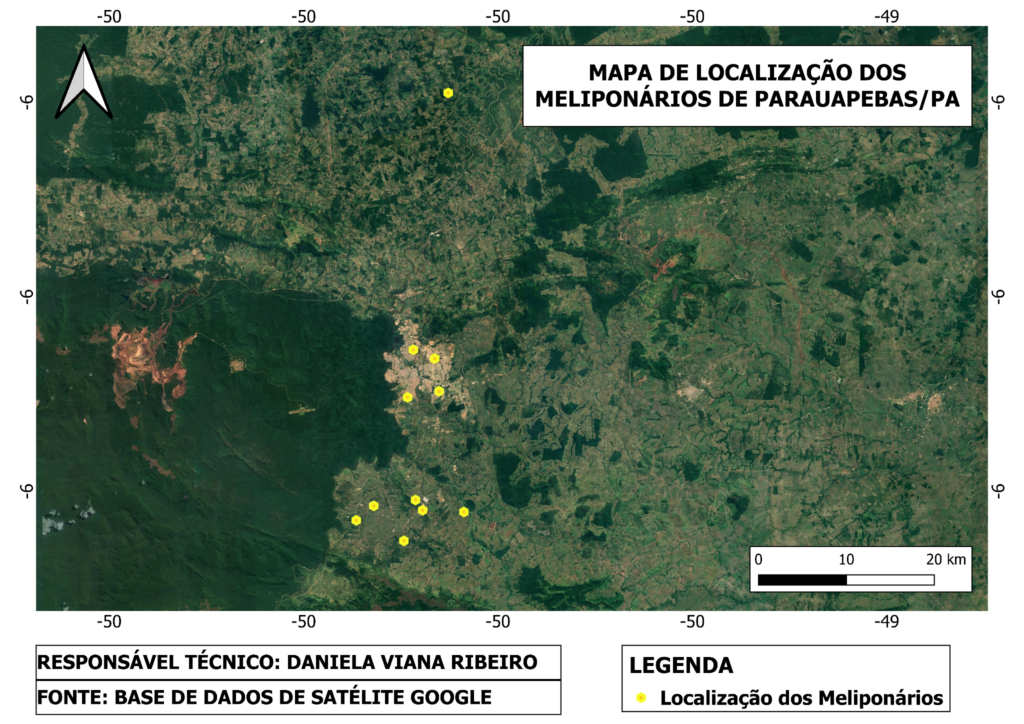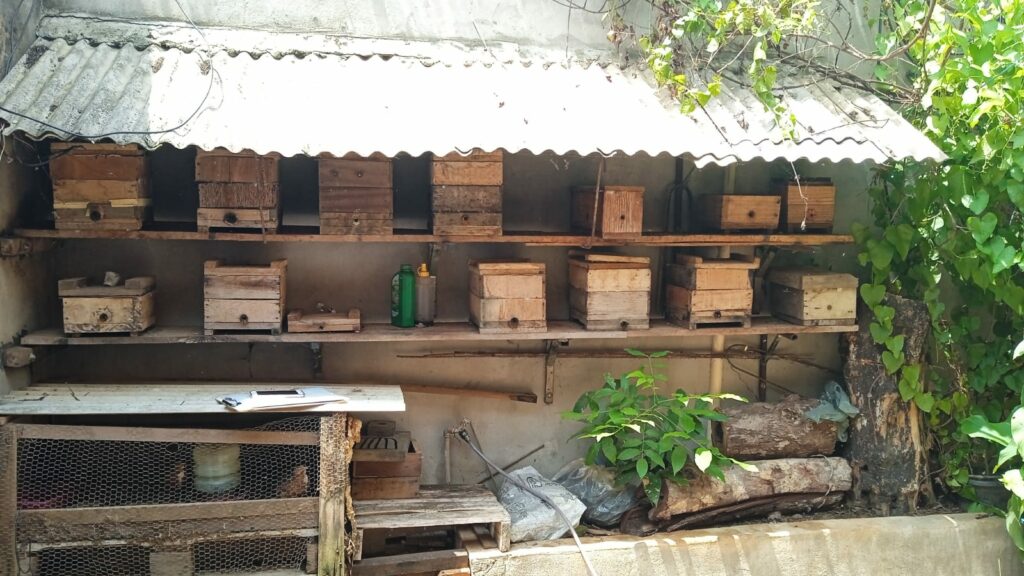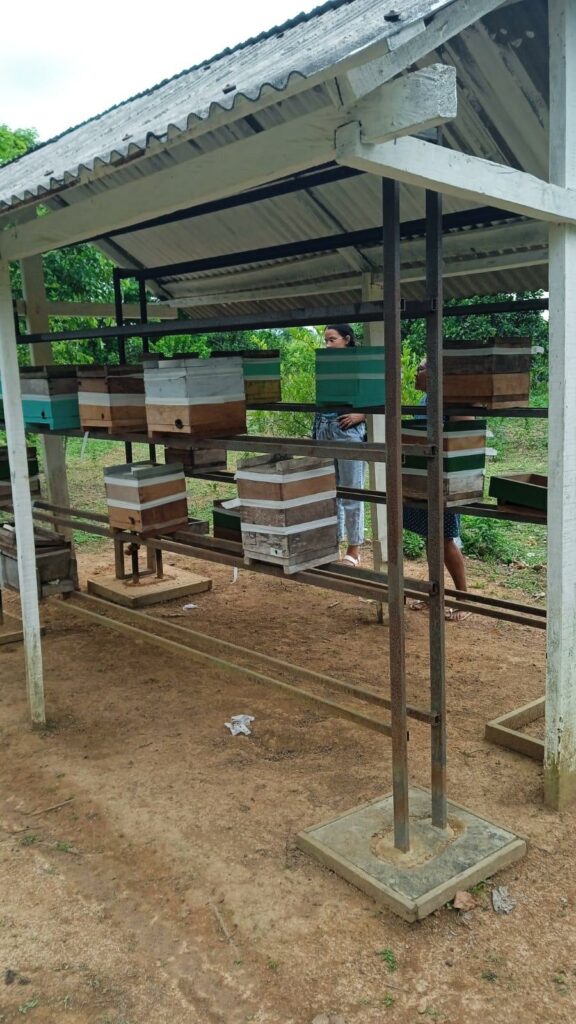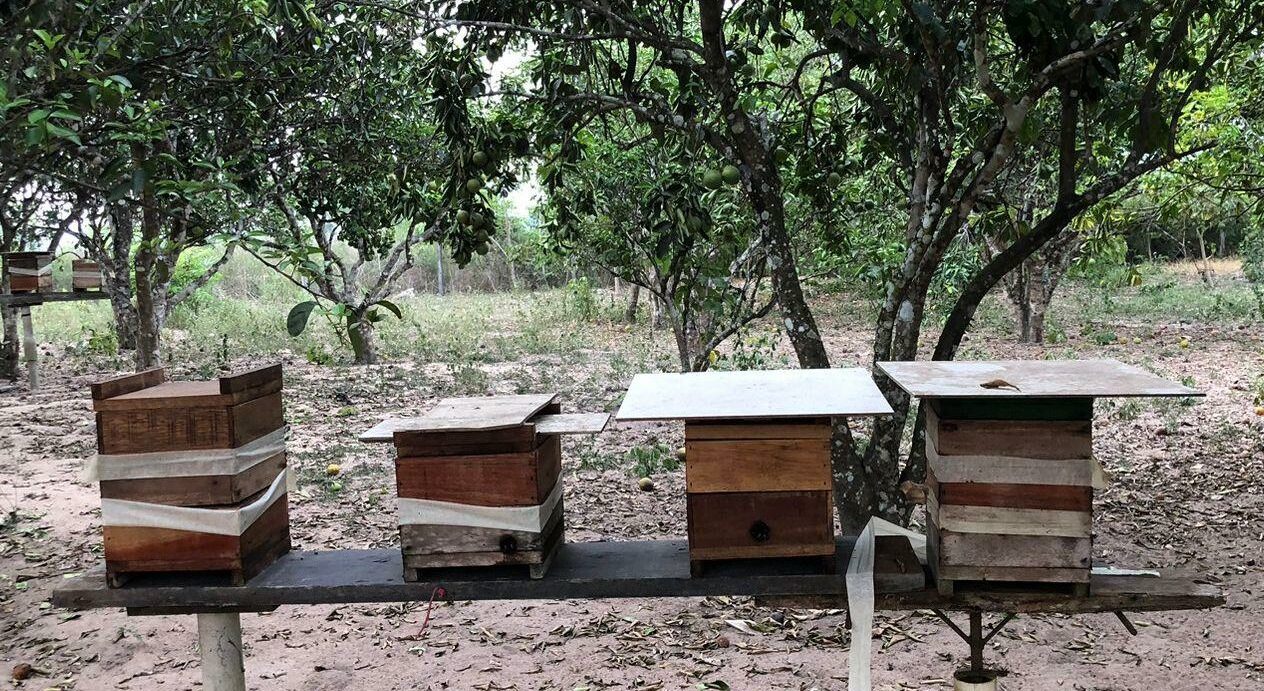Awareness on the importance of stingless bees to the environment has been inducing residents of Parauapebas/PA to become meliponicultors.
Author: Daniela Ribeiro
Leia em português
Meliponiculture, which consists in the farming of stingless bees, is an important activity for the amazon region because it is considered a good alternative for better use of land. Considering the relevance of meliponiculture, it is important to carry out surveys of the activity profile of a region to better understand its status and, thus, conduct it more appropriately.
The characterization of the meliponiculture profile in Parauapebas, city in the southeast of Pará, near the National Forest of Carajás (FLONA), where the biggest iron quarry of the world is located, the Carajás quarry. The research was conducted as part of my bachelor thesis in Agronomy by the Federal Rural University of Amazônia (UFRA), Parauapebas campus.
For the survey, we got the contact of 15 meliponicultors for interview through the Municipal Secretary of Rural Production (SEMPROR) and the Associação Filhas do Mel da Amazônia (AFMA). The questionnaire applied had the goal of obtaining various informations about stingless bee farming in the city. Next, I will describe the main results regarding the characteristics of meliponicultors in the city of Parauapebas/PA.
Meliponiculture in Parauabebas
The meliponaries are present mostly in the rural area, but can also be found in the urban region however in smaller proportions. This is called Urban Meliponiculture.

One of the main goals on the nurturing of bees refers tho their conservation. This highlights the environmental awareness of the residents who, because they understand the importance that these animals have for the environment, practice meliponiculture. Aside from conservation, the consumption of honey and leisure are other goals frequently pointed by the meliponicultors. This result reflects the medicinal properties of honey and the ease of handling stingless bees, which leads many to say that the activity promotes well-being and is therapeutic.

Therefore, meliponiculture stands out as a great tool of environmental education. It not only promotes awareness around preservation of natural resources, but it also offers ease of handling. This allows for people of all ages to get involved in this activity as a source of leisure and learning, even in urban areas.
One very interesting thing seen during the visits was the property of one of the meliponicutors, who recently started this activity, but already has many hives. His squad of stingless bees is in the same area as the lime orchard, and he noticed that after the introduction of those bees in the area, the production of the orchard significantly increased. Some branches even broke with the weight of the fruits. It is possible to see in the field the benefits that meliponiculture brings, both directly with honey production, and indirectly with pollination. Such evidences show that this activity is well used in association with agriculture, aside from the ecosystem services of native pollination provided by bees.

Photo: Daniela Ribeiro
It is also common among the meliponicultors the practice of apiculture, some of them have their main source of income throught this activity. In addition, the participation of the Associação Filhas do Mel da Amazônia (AFMA), though more focused in the commercialization of honey from Apis bees (honeybees), also provides support for breeders of stingless bees. They donate boxes for the multiplication of colonies and participate in fairs to sell honey from both stingless bees and honeybees. Aside from the help from AFMA, many of the meliponicultors also receive technical aid through SEMPROR.


To most of the breeders, the activity is a source of complementary income, through the commercialization of honey. However, there are also meliponicultors that don’t get any income through this activity, they do it for the reasons specified above. This reinforces once again the benefits in the well-being through the handling of stingless bees, since even without any additional income the activity is common in Parauapebas.
Among the meliponicultors in Parauapebas, there are those who started the activity at least 15 years ago. However, most of them started doing it recently. This can be due to the greater media spotlight around meliponiculture and more offer of courses, specially online. Truly, most breeders have had some access to technical training. The availability of free courses on the subject is an excellent tool to the strengthening of the activity, because it reaches new audiences as well as trains those who already practice bee handling.

Source: Rosemir

About obtaining the stingless bees colonies, the most common way to start a meliponary was the rescue. This consists in the removal from nature of colonies that are on fallen trees. This method can be considered sustainable, since it doesn’t result in environmental degradation with tree logging. This information once again highlights the concern and responsibility among beekeepers to preserve the environment, not using aggressive methods of collecting stingless bees.
The most common species of stingless bee in meliponaries is Melipona seminigra (Uruçu boca-de-renda). According to the National Catalog of Native Stingless Bees, stablished by Ordinance No. 665 of November 3rd 2021, this is a species that has the entire state of Pará as their natural habitat. For meliponiculture to be successful and taking into account species conservation, it is crucial that the chosen species are in their natural area of occurrence. This occurs due to difficulties in acclimation with the risk of death to the colony, in addition to the risk of disease transmission and production of diploid males (due to the low number of bees of the species in the area), making breeding unfeasible.
Regarding the challenges faced by meliponic growers, the most important are related to environmental difficulties, such as the lack of flowering, the occurrence of pests, diseases and fire. In addition, technological difficulties were also reported, such as the lack of registration in the activity and the lack of honey regulation. It is interesting to note that the lack of flowering is one of the main difficulties. It is a surprising result considering that the majority of meliponaries are found in rural areas, that is, places where there is a greater presence of vegetation compared to the urban region. This difficulty may be the result of environmental degradation, or even the lack of availability of floral species that are part of the preference group of stingless bees raised.

In general, most meliponicultors indicate that they are very interested in continuing in the activity, despite the difficulties mentioned, since the benefits found, such as income and well-being, for example, outweigh the difficulties. It was even reported that there was an interest in making the activity more profitable. Furthermore, it is evident how relevant the activity is to the Amazon region, as it is capable of generating an understanding of environmental conservation among meliponists, inducing them to practice ecological management, seeking alternatives that do not harm the environment.
For more information about the profile of meliponiculture in Parauapebas, access the link to access the full work in Portuguese.
Your donation can have a positive impact on the world!
Subscribe to receive our Newsletter!
Find us also at Linkedin, Facebook, Twitter or Instagram
www.meli-bees.org
❤️


Meliponiculture in Parauapebas, as discussed by Daniela Ribeiro, shows how farming stingless bees benefits both the environment and the community. Residents, recognizing the bees’ importance, practice meliponiculture for conservation, honey, and leisure. It’s interesting to see how introducing these bees to an orchard increased fruit production, demonstrating the positive impact on agriculture.
This practice isn’t confined to rural areas; there’s a growing trend of Urban Meliponiculture. Beyond honey production, meliponiculture serves as a hands-on tool for environmental education. Its ease of handling and therapeutic aspects make it accessible to people of all ages, fostering a connection between humans and nature.